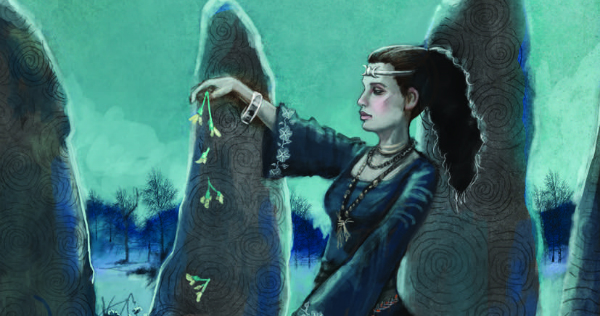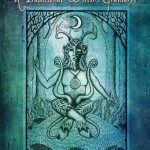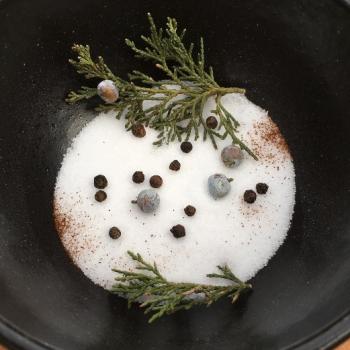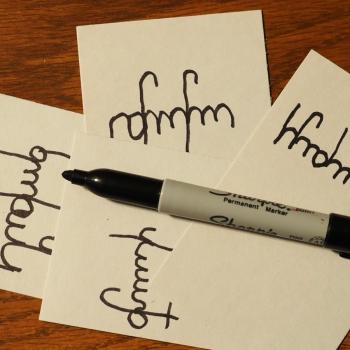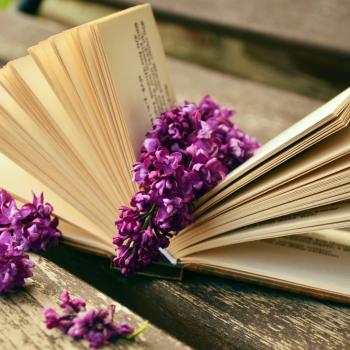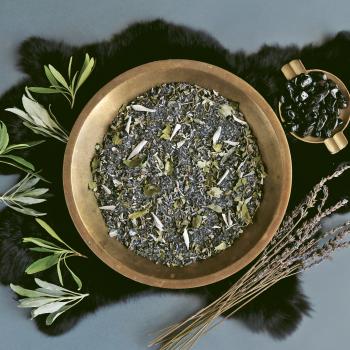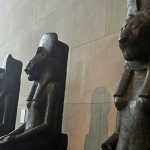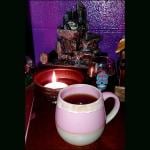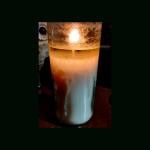Ann Moura is probably best known for her books on Green Witchcraft but she’s also written about tarot and is an accomplished tarot reader. This summer she released her first deck, The Green Witch Tarot with artist Kiri Ostergaard Leonard.
What is your background in reading cards?
I have been reading cards for over 50 years. I started reading with ordinary playing cards as a child when my mother taught me how to play Solitaire. I would see things moving in the cards and receive sensations. As I got older, I would read the cards for friends. My first tarot deck was the Rider-Waite when I was in college, but I never felt close to it because I found the colors too garish. Tarot cards were a rare find back then, but I started collecting them right away, looking for one that felt right.
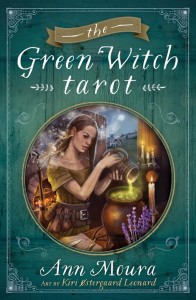 You said you collected decks, so how many tarot decks do you have?
You said you collected decks, so how many tarot decks do you have?
I recently gleaned out some of the ones I rarely used, so now I am down to around 75 decks from a former count of over 145 decks. For public readings, I tend to choose between 3 or 4 decks, at least one of which is now out of print. I find that some decks are good for certain types of readings, while others relate well to family members or to the seasons or lunar phases, so those are the decks that get used periodically. Now that my own deck is available, the others will see less use unless there is an energy calling that resonates with a querant (person getting a reading).
How do you feel about having a Green Witch Tarot now?
I am thrilled and excited about having my very own tarot deck! This deck is definitely my primary one for readings not only because I know it from within myself, but also because Kiri’s art work makes it resonate on so many levels. The cards are visually stimulating but beyond that they convey a depth and expanse of meanings that can change during a reading to open greater insight and interpretation. These cards are also an excellent tool for path working, and meditation. I already foresee spending many meditation sessions with each of the cards.
It sounds like you originally read cards intuitively. Do you still recommend that over reading them literally?
I read with both the general meaning of the cards and the intuitive insight the cards generate. For example, I once drew the 2 of Swords for a querant and saw there was some negotiations going on (which was verified), but then the cards became three dimensional, showing two young boys, twins, about 7 years old, playing together with building blocks (also verified by the querant). In an instant, I saw them grown up working together as successful architects. So while the cards have certain meanings, they are also a doorway to the psychic realms.
What is different about the Green Witch Tarot deck, or is it the same as the Rider Waite format?
The Green Witch Tarot is based in Nature, the Elementals, Faerie, and our connection to these. I see the tarot as evolving through the centuries from the Viscount Sforza deck of the 1450’s onward, with a baseline meaning, but also with embellishments that identify certain decks. Thus there are decks featuring dragon, mermaid, cat, gothic, pagan, fairy, saint, cultural, and even literary imagery. The Major Arcana of the Green Witch Tarot shows mainly the aspects and interactions of the Goddess and the God, the Elementals, Faerie Folk, and those who work with them: Witches, Priestesses, Priests, as well as Universal archetypes of change and balance.
The Minor Arcana utilizes the ritual tools of the Craft: pentacles, athames, wands, and chalices, with a focus of everyday country or village life. Even the court cards are ordinary folk in differing circumstances and are easily identifiable. The pages and knights represent children and young adults, so there are 2 males and 2 females for each. Every card in the deck has a specific plant and animal to aid with gaining more insight or to act as a prompt for the reader for meaning. Many cards are open to interpretation, allowing the reader to follow the basic meaning or delve into deeper or extended meanings as more elements arise into view and offer alternate or different perspectives.
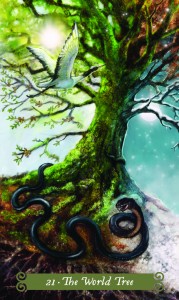 Are you happy with the way the cards turned out?
Are you happy with the way the cards turned out?
There are no sufficient words to describe my delight with these cards! The art work by Kiri Ostergaard Leonard is amazing and draws the reader into the scenes where more and more elements spring forward to the psychic awareness of the reader. The overall look is deep and vibrant, yet each card is a distinct component within the whole. For me, it was as though Kiri was inside my head, seeing my vision and translating it into art. Everyone involved with the process of bringing this deck into manifestation worked so beautifully together that the whole production was magical!
What meaning do you ascribe to the card backs?
The card back features a rustic wooden door — green for Nature, herbal magic, and Faerie. On the door is a wreath of roses with their stems and thorns. Roses represent the Goddess, the vine and leaves is for the God, and the thorns are for the Faerie Folk, who are often associated with brambles and even tangled hair called elf-knots. Inside this circle is a 5-pointed star made of rosemary sprigs, representing protection for the reader, connection with elves and Other People of Faerie, and the harmony of the Elementals with the individual through Spirit. So this door forms the threshold the reader crosses from the ordinary world into the psychic world of intuition and spiritual communion once the cards are turned over in a reading.
 Should the querant handle the cards prior to the reading?
Should the querant handle the cards prior to the reading?
Many readers let the querant shuffle the cards or pull them from a fanned out line of cards, but I personally do not. First of all, not all querants know how to shuffle cards, resulting in torn edges and damaged cards. If a reader is not sure how to shuffling the cards, practicing with an inexpensive deck of regular playing cards will help. Keeping the cards loose in the hands and shuffling them gently helps to prevent ripped edges. I very lightly give the deck a couple of shuffles, then set the cards in front of the querant and tell the person to “knock on the cards like knocking on a door”.
They usually knock between one and three times, but I had one querant who counted out 13 knocks! Next, I push that energy into the cards with the palms of my hands, pick the deck up, carefully split it, and restack so the bottom half is now resting on the top half. I feel the energy permeate all the cards, then I shuffle the deck until the shuffle feels right. Now the cards are ready to be laid out in a spread and read. When the reading is finished, the cards can be held and fanned out, then passed through incense smoke, or simply given a vigorous wave in the air for Elemental Air to clear them of the querant’s energy. By limiting the amount of energy a person puts into the cards I know there will not be a build up of other people’s energies in them.
How do you see the cards as useful?
I always tell querants that the cards show the energies that are around them, departing, and coming. As energy is always in motion, the cards alert a person to what energies are a current influence, what energies are dissipating, and what energies are coming into play. The individual can then be aware of the energy flow and work with it, around it, or against it. Sometimes simply using verbal or mental positive affirmations will deflect an unwanted energy, other times lighting a candle and calling upon spirit guides, the angelic realm, or the Divine for protection or guidance will be helpful to move the energy in a more positive way.
When the cards show desirable energies, a person can let things continue as they are, add their own enthusiasm to the energy, or utilize that energy to accomplish desired goals. For unwanted energies, a person could carry a protective or warding stone or wear such a stone in jewelry. Black tourmaline, fire agate, red jasper, golden tiger’s eye, or black onyx are all good protection stones that also ward negativity and can be carried in a pocket or worn as jewelry. There are many options to moving unwanted energies or transmuting them into positive energies, using candles, stones, essential oils, incenses, smudges, herbal charm bags, astrological or star symbols, and so on. I cover a number of options in Grimoire for the Green Witch. But on their own, the cards are not creating the energies, merely letting one know what the energies are, which can be useful information for making plans or understanding situations better.
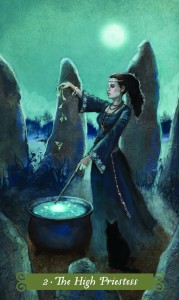 What do you suggest for new readers?
What do you suggest for new readers?
When getting a new deck, a reader should look at each card of the tarot and examine the images and details. See if something in the card catches the eye or opens an intuitive impression. The Green Witch Tarot comes with a Tarot Companion book, and most decks will have at least a booklet with the cards. Read the descriptions and interpretation options for each card while looking at it. Then try out a simple spread with the cards. If the reader is getting something different from the cards than is the normal meaning, that is an intuitive or psychic connection that should not be ignored.
Readers need to learn to trust the insights, but when reading for another person, it is okay to ask the querant if the impression received is meaningful. If not, the reader can gather the cards back up, clear them (as previously described), and have the person knock on the cards again, then reshuffle and lay them out. Sometimes a residual energy from a prior reading may have been the problem, but my experience has been that normally the same cards will come up again. Go with that, and explain that this is the energy the cards are showing, and that if it does not resonate now, it may be clearer to the querant later.
A reading is generally good for up to 6 months, so try not to read for the same person too often. Doing an occasional reading for oneself, using the cards for meditation, and doing path work with the cards is beneficial, but be careful not to get obsessive about them. Once the energy alignments are known, there is no need to be dependent on the cards for every decision or moment of the day. If there is a question about a card after the spread is laid, the reader may add some additional cards on it for further insight. Remember when doing readings for others that they might ascribe greater importance to a reader’s words than the reader does, so be careful, considerate, and tactful with the messages being delivered.


